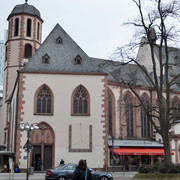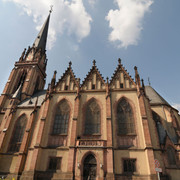Visitors are sure to enjoy its harmonious carillon, the chimes of which are tolled by a total of 47 bells.
This small church, dating back to the 13th century, presumably served as a royal chapel for Stauferian nobility. First official mention dates back to 24 September 1264. The chapel may well have served as electoral site for kings and parliaments. The church was sanctified in the name of St Nicolas of Bari in 1290. Later, the church became the preferred place of worship for the city's councillors. A Gothic-style gallery was added in 1476, from which the councilmen could watch the festivities. Two significant tombstones are located in the interior, honouring Siegfried zum Paradies and Katharina Netheha zum Wedel. Both were created by Madern Gerthener (1410/1420).
This small church, dating back to the 13th century, presumably served as a royal chapel for Stauferian nobility. First official mention dates back to 24 September 1264. The chapel may well have served as electoral site for kings and parliaments. The church was sanctified in the name of St Nicolas of Bari in 1290. Later, the church became the preferred place of worship for the city's councillors. A Gothic-style gallery was added in 1476, from which the councilmen could watch the festivities. Two significant tombstones are located in the interior, honouring Siegfried zum Paradies and Katharina Netheha zum Wedel. Both were created by Madern Gerthener (1410/1420).
Nearby






